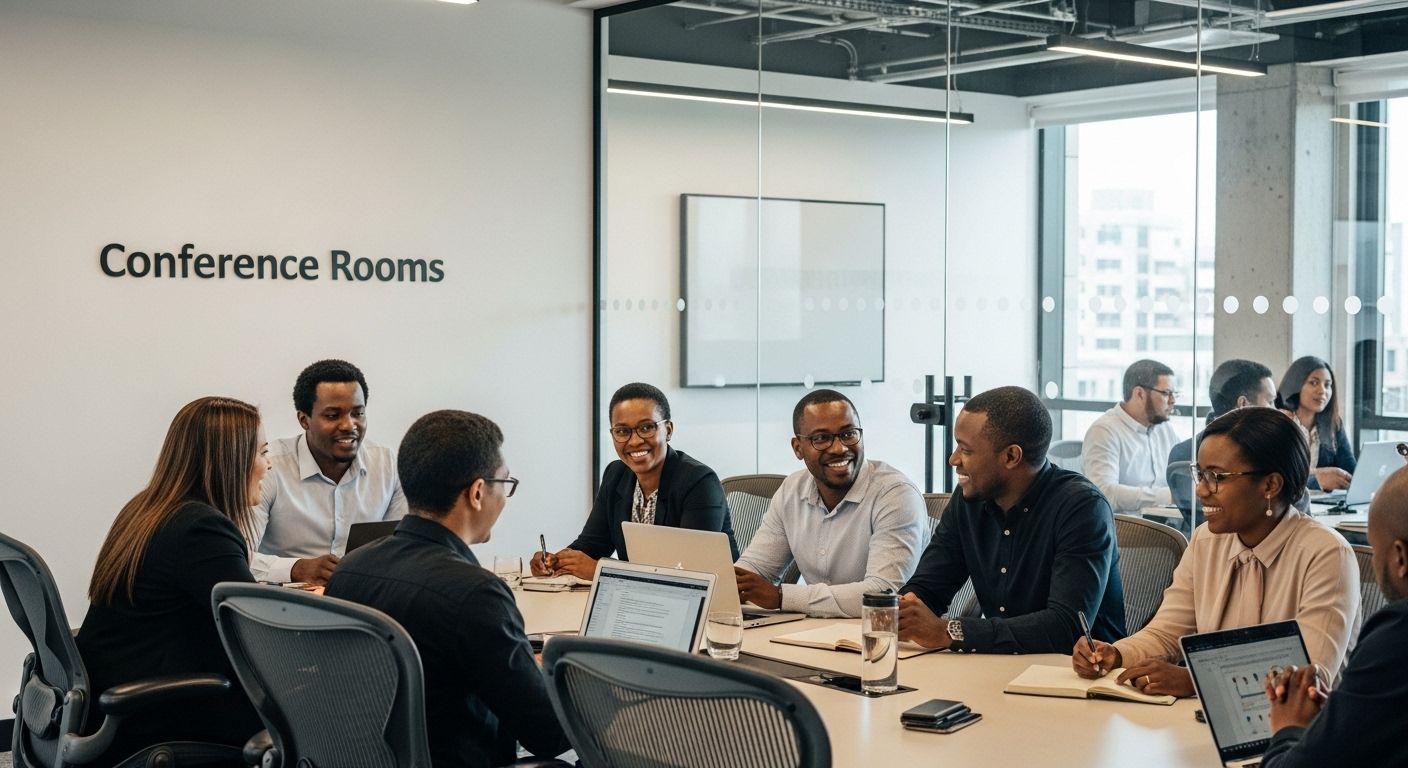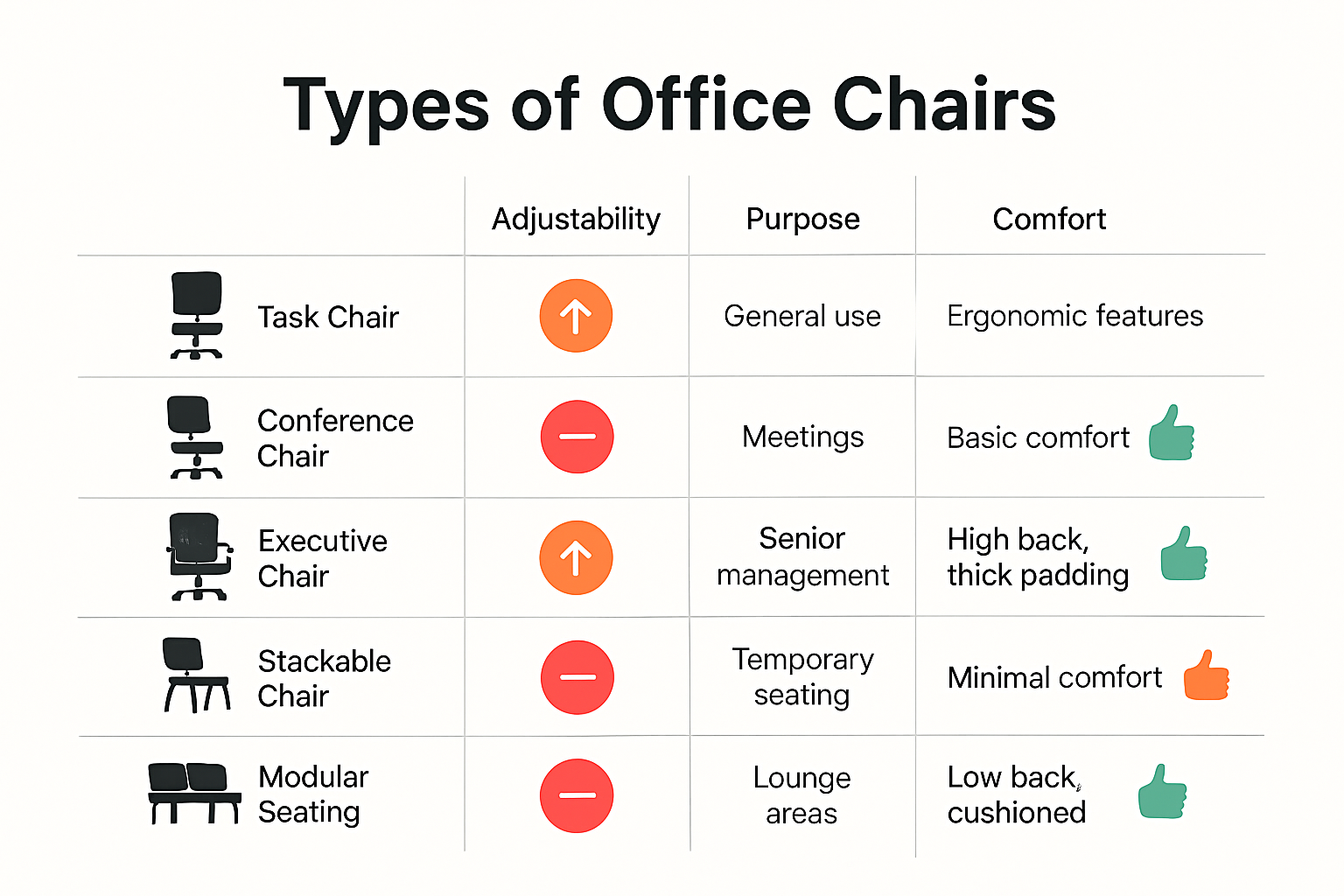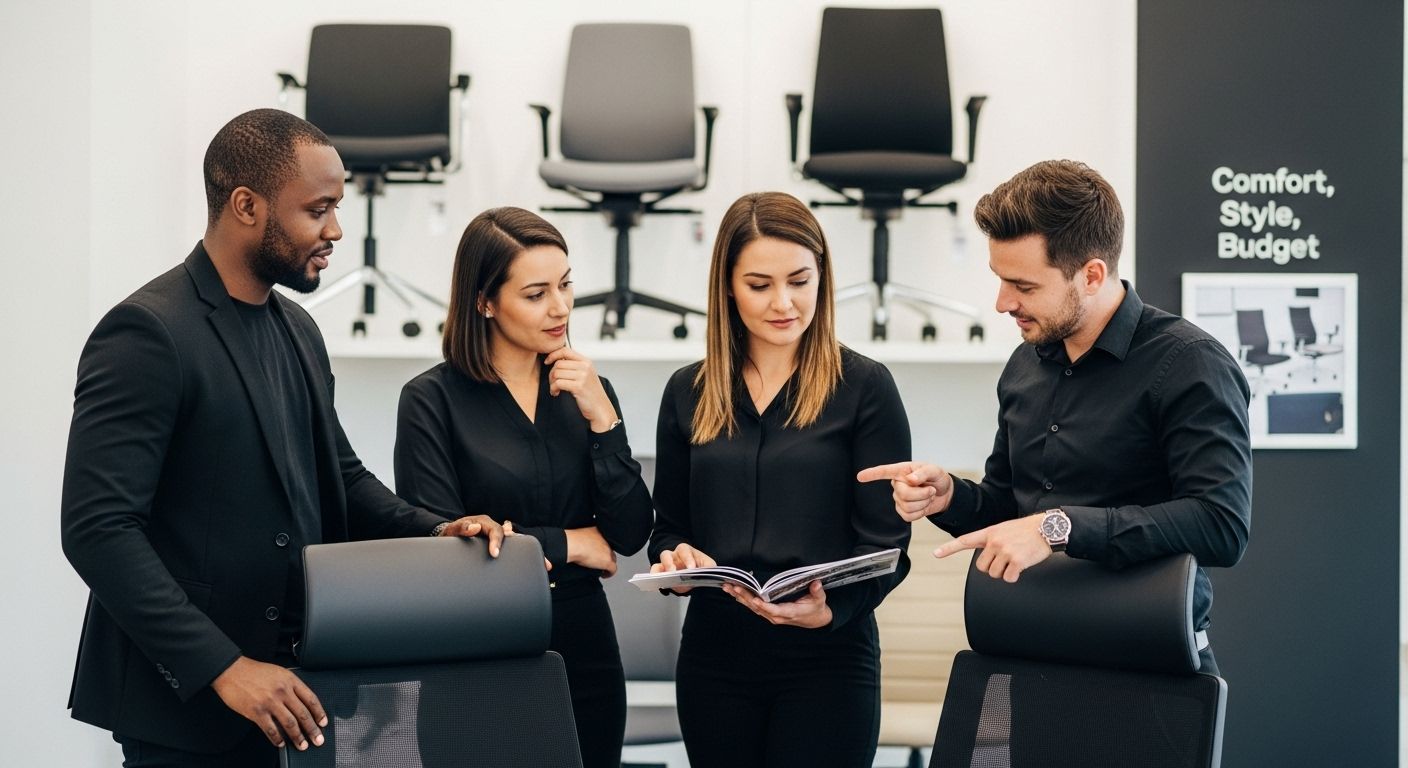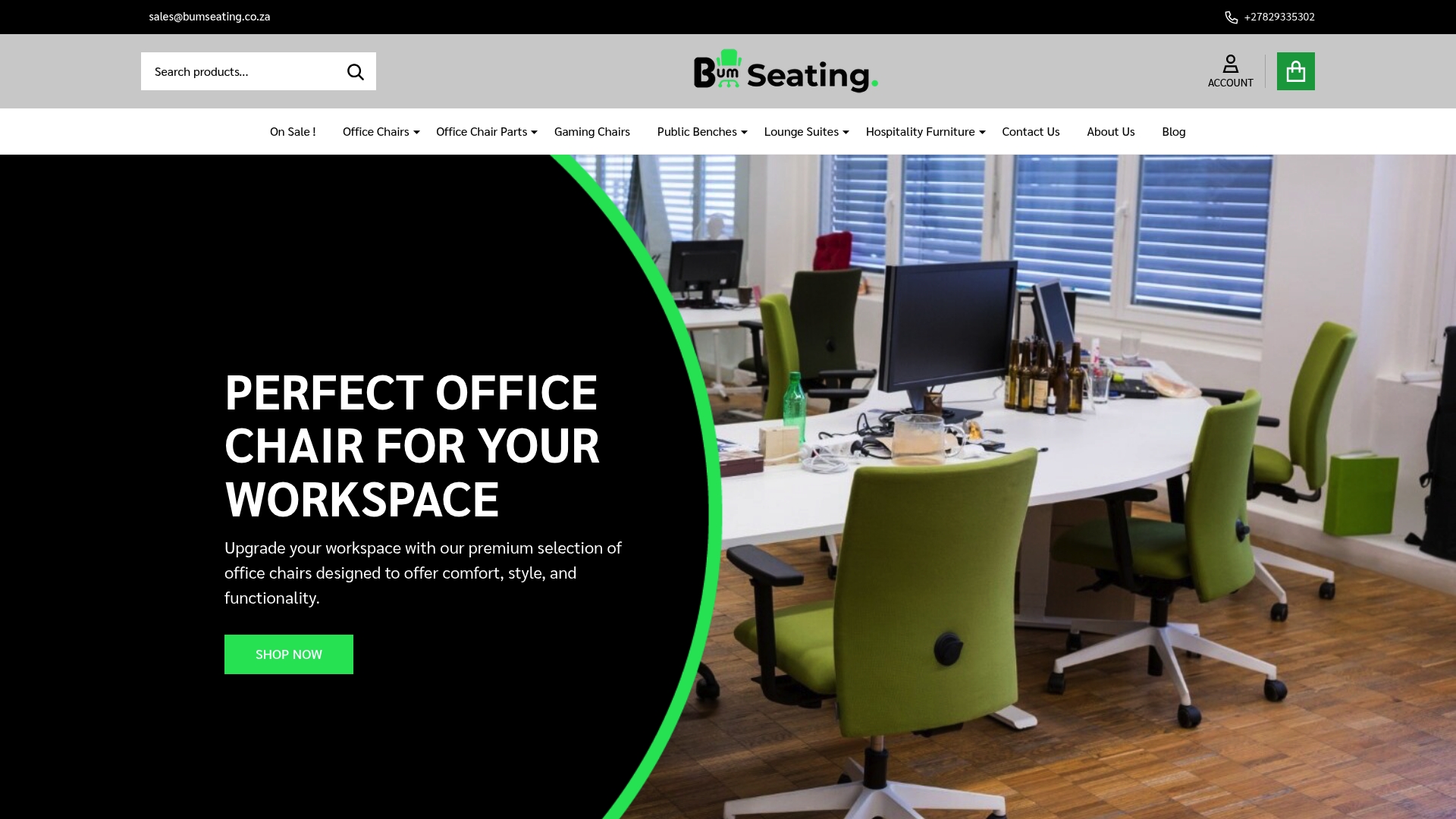Choosing Chairs for Conference Rooms: A Complete Guide
18th Aug 2025
Choosing Chairs for Conference Rooms: A Complete Guide

Conference room chairs sound like a small detail until you realise just how much time we actually spend in meetings. Some South Africans can sit for up to six hours a week in one chair. Most expect sore backs and restless legs after long sessions, but that is not a given. The right chair can actually raise productivity and make meetings less painful than you ever thought possible.
Table of Contents
- Key Factors When Choosing Conference Chairs
- Comparing Chair Types For Office Needs
- Balancing Comfort, Style And Budget
- Tips For South African Businesses And Spaces
Quick Summary
| Takeaway | Explanation |
|---|---|
| Prioritize ergonomic design for comfort | Ergonomic conference chairs support diverse body types and enhance productivity during meetings. Consider features like lumbar support and adjustable height. |
| Choose durable and sustainable materials | Select chairs made from high-quality, easy-to-clean, and environmentally-friendly materials to ensure longevity and alignment with sustainability standards. |
| Ensure accessibility compliance | Conference chairs should cater to individuals with diverse physical capabilities. Follow ADA standards to enhance inclusivity and comfort in the workspace. |
| Understand chair types and their purposes | Differentiate between task chairs and conference chairs based on their intended use, ensuring the right choice for collaborative environments. |
| Balance comfort, style, and budget | Invest strategically in seating that reflects workplace identity while addressing ergonomic needs, ensuring both visual appeal and financial viability. |
Key Factors When Choosing Conference Chairs
Selecting the right chairs for conference rooms requires careful consideration of multiple critical factors that impact comfort, productivity, and overall workplace functionality. Bum Seating understands that conference room seating is more than just furniture—it’s an investment in your organization’s collaborative environment.
Ergonomic Design and Comfort
Ergonomics play a pivotal role in choosing conference chairs. According to the GSA Sustainable Facilities Tool, high-quality seating options must provide flexibility and support to accommodate diverse body types and sitting preferences. Chairs should offer adjustable features like seat height, lumbar support, armrest positioning, and tilt mechanisms to ensure maximum comfort during extended meetings.
The ideal conference chair combines multiple ergonomic elements. Look for chairs with:
Below is a summary of key ergonomic features to look for when selecting conference room chairs, along with the purpose or benefit of each feature.
| Ergonomic Feature | Purpose / Benefit |
|---|---|
| Lumbar Support | Maintains proper spine alignment |
| Adjustable Armrests | Reduces shoulder and neck strain |
| Breathable Materials | Prevents discomfort in long meetings |
| Seat Height Adjustment | Accommodates diverse body types |
| Tilt Mechanism | Enhances flexibility and comfort |
- Lumbar Support: Maintains proper spine alignment
- Adjustable Armrests: Reduces shoulder and neck strain
- Breathable Materials: Prevents discomfort during long sessions
Additionally, research from workplace design experts emphasizes that proper seating directly influences meeting productivity and participant engagement. Uncomfortable chairs can lead to decreased attention spans and reduced collaboration effectiveness.
Durability and Material Considerations
Conference room chairs must withstand frequent use and maintain aesthetic appeal. Professional environments demand furniture that balances durability with sophisticated design. When evaluating materials, consider factors such as:
- Upholstery resistance to wear and tear
- Easy-to-clean surfaces
- Fire-resistant and sustainable material options
Bum Seating recommends selecting chairs constructed with high-quality, recyclable materials that align with modern workplace sustainability standards. The Whole Building Design Guide suggests avoiding materials containing harmful chemicals like brominated flame retardants and prioritizing environmentally responsible options.
Accessibility and Compliance
Accessibility is a critical consideration often overlooked when selecting conference chairs. The International Building Code and ADA Standards for Accessible Design mandate that conference room furniture accommodate individuals with diverse physical capabilities.
Key accessibility features include:
- Appropriate seat width and depth
- Adequate weight capacity
- Options for individuals with mobility challenges
- Clear pathways between chairs
By prioritizing these key factors, organizations can create conference room environments that promote comfort, productivity, and inclusivity. Learn more about our ergonomic seating solutions that transform workplace collaboration.
Remember, the right conference chairs are an investment in your team’s performance and well-being. Choose wisely, choose Bum Seating.
Comparing Chair Types for Office Needs
Choosing the right chair for conference rooms involves understanding the nuanced differences between various seating options. Bum Seating recognizes that not all chairs are created equal, and selecting the appropriate type can significantly impact meeting productivity, participant comfort, and overall workplace dynamics.
Task Chairs vs Conference Chairs
Task chairs and conference chairs might seem similar, but they serve distinctly different purposes. According to the Business and Institutional Furniture Manufacturers Association, these chair types have specific design characteristics tailored to their intended use.
To help you differentiate between task chairs and conference chairs, here’s a comparison table highlighting their key features and intended uses.
| Feature / Aspect | Task Chairs | Conference Chairs |
|---|---|---|
| Primary Use | Individual workstations | Collaborative meeting environments |
| Adjustability | Highly adjustable (many settings) | Moderately adjustable |
| Duration of Use | Extended daily use | Shorter, intermittent use |
| Customisation | Optimised for personal setup | Designed for group comfort |
| Design Focus | Ergonomics and individual support | Aesthetic consistency and interaction |
| Example Features | Seat height, lumbar, armrest, tilt | Unified style, easy reconfiguration |
| Visual Impact | Varies between workstations | Consistent visual theme |
Task chairs are typically designed for individual workstations, featuring:
- High adjustability: Multiple ergonomic settings
- Personal customization: Meant for extended daily use
- Individual focus: Optimized for personal workspace
Conference chairs, by contrast, are engineered for collaborative environments. They prioritize:

- Group interaction: Promoting communication and engagement
- Consistent design: Creating a unified aesthetic
- Moderate adjustability: Balanced comfort for shorter meeting durations
Explore our comprehensive chair selection to understand the nuanced differences between these chair types.
Specialized Conference Seating Options
Modern conference rooms demand versatility. The Whole Building Design Guide emphasizes the importance of selecting furniture that adapts to various meeting styles and organizational needs.
Key conference chair varieties include:
- Executive Chairs: High-back designs signaling authority and professionalism
- Stackable Chairs: Perfect for flexible spaces requiring quick reconfiguration
- Swivel Chairs: Enabling easy interaction and collaboration
- Modular Seating: Adaptable configurations for dynamic meeting environments
Each chair type offers unique advantages. Executive chairs communicate leadership and status, while stackable chairs provide practical solutions for spaces with changing requirements. Swivel chairs facilitate seamless communication, and modular seating allows unprecedented flexibility in meeting room design.
Ergonomic Considerations and Workplace Dynamics
Beyond aesthetic considerations, chair selection directly impacts workplace productivity and employee well-being. The right conference chair can transform meeting experiences, encouraging engagement, comfort, and effective collaboration.
Critical ergonomic factors to consider include:
- Weight distribution
- Lumbar support
- Material breathability
- Adjustability range
- Compatibility with different body types
Discover our ergonomic seating solutions that blend comfort, style, and functionality. Bum Seating understands that choosing the right conference chair is more than a furniture decision—it’s an investment in your team’s performance and workplace culture.
Remember, the perfect conference chair balances form, function, and comfort. Choose wisely, choose Bum Seating.
Balancing Comfort, Style and Budget
Designing conference room seating requires a strategic approach that harmonizes employee comfort, workplace aesthetics, and financial considerations. Bum Seating recognizes that selecting the right chairs involves more than just price tags—it’s about creating an environment that promotes productivity, reflects organizational culture, and provides long-term value.
Prioritizing Ergonomic Investment
Global Gurus emphasize that upgrading conference rooms doesn’t mean exhausting financial resources. The key is strategic investment in core elements that significantly impact workplace performance. Ergonomic chairs represent a critical investment that directly influences employee comfort and productivity.
When balancing budget with quality, consider:
- Long-term durability: Chairs that withstand frequent use
- Adjustable features: Accommodating diverse body types
- Material quality: Resistance to wear and tear
- Warranty coverage: Protecting your investment
According to the American Society for the Positive Care of Children, investing in quality chairs yields substantial returns through enhanced employee satisfaction and reduced potential health-related productivity losses.
Aesthetic Considerations and Workplace Identity
Conference room chairs are more than functional items—they’re visual representatives of your organizational culture. The design should complement your workspace’s overall aesthetic while maintaining professional standards. Learn more about creating cohesive office environments.
Consider these style considerations:
- Color coordination: Matching company branding
- Design consistency: Creating a unified look
- Material selection: Reflecting corporate values
- Modern vs. traditional designs: Aligning with organizational personality
Style doesn’t necessitate astronomical expenses. Intelligent selection can create impressive visual impact without compromising budgetary constraints.
Strategic Budgeting for Conference Room Seating
Effective budgeting requires a holistic view of chair selection. iN Education Inc. highlights the importance of chairs that promote collaboration and mobility—principles equally applicable to conference room environments.
Budget-conscious strategies include:
- Purchasing chairs in bulk for potential discounts
- Selecting versatile designs applicable across multiple spaces
- Considering modular furniture with adaptable configurations
- Evaluating total cost of ownership, not just initial price
Bum Seating recommends a balanced approach: allocate resources toward critical ergonomic features while maintaining aesthetic appeal. Remember that cheaper isn’t always more economical—chairs representing a thoughtful investment can significantly enhance workplace productivity and employee well-being.

Ultimately, successful conference room chair selection transcends mere furniture procurement. It’s about creating spaces that inspire collaboration, reflect organizational values, and support employee performance. Choose wisely, choose Bum Seating.
Tips for South African Businesses and Spaces
Navigating conference room chair selection requires nuanced understanding of local business environments, workplace dynamics, and ergonomic standards specific to South African contexts. Bum Seating recognizes that successful furniture solutions must balance international best practices with unique regional requirements.
Understanding Local Workplace Ergonomics
The Centers for Disease Control and Prevention emphasizes that proper chair selection goes beyond aesthetic considerations, focusing on preventing musculoskeletal disorders and supporting employee health. For South African businesses, this means selecting chairs that accommodate diverse workforce physiques and working conditions.
Key ergonomic considerations for local spaces include:
- Cultural diversity: Chairs supporting varied body types
- Climate adaptability: Breathable materials suitable for warmer environments
- Durability: Furniture withstanding potential transportation challenges
- Flexible configurations: Adaptable to different office layouts
Ergonomic chairs represent more than comfort—they’re an investment in workforce productivity and well-being. Explore our comprehensive ergonomic solutions tailored for South African workspaces.
Regional Budget and Procurement Strategies
South African businesses face unique economic constraints that demand strategic furniture procurement. Understanding local market dynamics helps organizations make informed purchasing decisions without compromising quality.
Consideration strategies include:
- Prioritizing local manufacturing where possible
- Investigating bulk purchase opportunities
- Evaluating long-term maintenance costs
- Exploring flexible payment structures
- Assessing import versus local production expenses
By carefully analyzing total cost of ownership, businesses can develop procurement strategies that balance financial prudence with workplace quality requirements.
Compliance and Cultural Considerations
Conference room design in South African contexts extends beyond functional requirements. It reflects organizational culture, demonstrates professional standards, and communicates corporate identity.
Critical factors to consider:
- Accessibility standards: Ensuring furniture accommodates employees with diverse physical abilities
- Cultural sensitivity: Selecting designs respectful of multicultural workplace environments
- Professional aesthetics: Balancing modern design with traditional corporate expectations
- Space optimization: Maximizing limited office areas efficiently
Bum Seating understands that conference room chairs are more than mere furniture—they’re strategic tools for enhancing workplace collaboration, productivity, and employee engagement.
Remember, choosing the right conference chairs involves comprehensive analysis of functional, cultural, and economic factors unique to South African business landscapes. By prioritizing employee comfort, organizational needs, and budget considerations, businesses can create dynamic, supportive meeting environments.
Choose wisely, choose Bum Seating—your partner in creating exceptional workplace experiences.
Frequently Asked Questions
What ergonomic features should I look for in conference chairs?
Look for chairs that offer lumbar support, adjustable armrests, seat height adjustment, and a tilt mechanism to enhance comfort during long meetings.
How can I ensure accessibility compliance with my conference chairs?
To ensure compliance, choose chairs that accommodate diverse body types, have appropriate seat widths and depths, and provide clear pathways for individuals with mobility challenges.
What is the difference between task chairs and conference chairs?
Task chairs are designed for individual workstations with high adjustability for personal comfort, while conference chairs focus on group interaction and a consistent aesthetic, suitable for collaborative environments.
How can I balance comfort, style, and budget when selecting conference chairs?
Prioritize ergonomic design and durability in your chairs, while also considering aesthetic consistency to reflect workplace identity. Strategic budgeting, like bulk purchases and evaluating total cost of ownership, can help maintain quality within budget.
Elevate Your Conference Room Comfort Today
You have put in the research and know that uncomfortable meetings hurt productivity and staff morale. From aching backs to restless energy in long sessions, the article highlighted how the wrong chair can hold your team back. The real solution lies in ergonomic support, flexibility, and style that adapts to your unique office space.

Ready to move beyond the pain points of sore backs and uninspired meeting rooms? Choose conference room seating proven to boost collaboration, comfort, and your professional image. Unlock the benefits of modern ergonomic chairs and browse our curated range of office seating solutions. For personalised advice or to secure the best deals on quality products, visit Bum Seating now. Act today and give your team a workspace they truly deserve.
